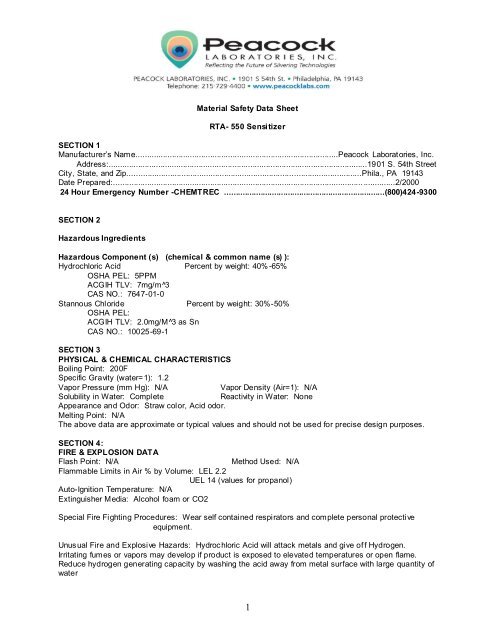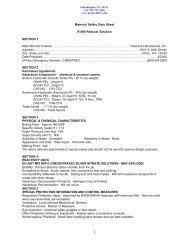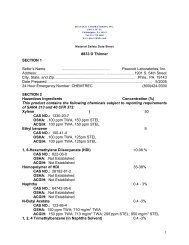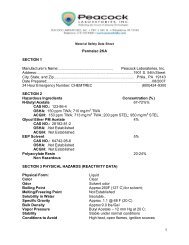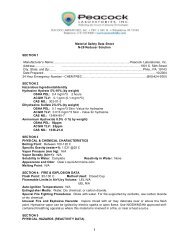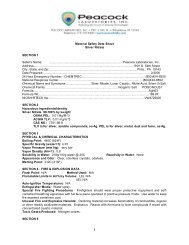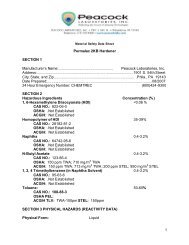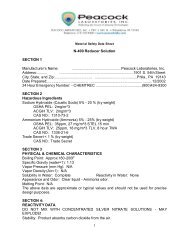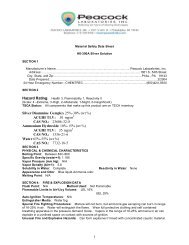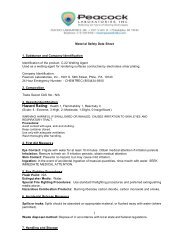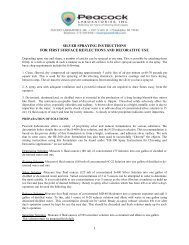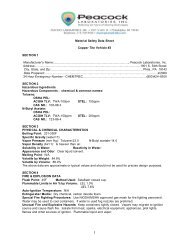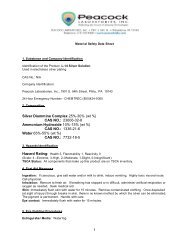RTA-550 Sensitizer - Peacock Laboratories
RTA-550 Sensitizer - Peacock Laboratories
RTA-550 Sensitizer - Peacock Laboratories
You also want an ePaper? Increase the reach of your titles
YUMPU automatically turns print PDFs into web optimized ePapers that Google loves.
Material Safety Data Sheet<br />
<strong>RTA</strong>- <strong>550</strong> <strong>Sensitizer</strong><br />
SECTION 1<br />
Manufacturer’s Name..........................................................................................<strong>Peacock</strong> <strong>Laboratories</strong>, Inc.<br />
Address:...................................................................................................................1901 S. 54th Street<br />
City, State, and Zip........................................................................................................Phila., PA 19143<br />
Date Prepared:............................................................................................................... ..............2/2000<br />
24 Hour Emergency Number -CHEMTREC .......................................................................(800)424-9300<br />
SECTION 2<br />
Hazardous Ingredients<br />
Hazardous Component (s) (chemical & common name (s) ):<br />
Hydrochloric Acid Percent by weight: 40% -65%<br />
OSHA PEL: 5PPM<br />
ACGIH TLV: 7mg/m^3<br />
CAS NO.: 7647-01-0<br />
Stannous Chloride Percent by weight: 30%-50%<br />
OSHA PEL:<br />
ACGIH TLV: 2.0mg/M^3 as Sn<br />
CAS NO.: 10025-69-1<br />
SECTION 3<br />
PHYSICAL & CHEMICAL CHARACTERISTICS<br />
Boiling Point: 200F<br />
Specific Gravity (water=1): 1.2<br />
Vapor Pressure (mm Hg): N/A<br />
Vapor Density (Air=1): N/A<br />
Solubility in Water: Complete<br />
Reactivity in Water: None<br />
Appearance and Odor: Straw color, Acid odor.<br />
Melting Point: N/A<br />
The above data are approximate or typical values and should not be used for precise design purposes.<br />
SECTION 4:<br />
FIRE & EXPLOSION DATA<br />
Flash Point: N/A<br />
Method Used: N/A<br />
Flammable Limits in Air % by Volume: LEL 2.2<br />
UEL 14 (values for propanol)<br />
Auto-Ignition Temperature: N/A<br />
Extinguisher Media: Alcohol foam or CO2<br />
Special Fire Fighting Procedures: Wear self contained respirators and complete personal protective<br />
equipment.<br />
Unusual Fire and Explosive Hazards: Hydrochloric Acid will attack metals and give of f Hydrogen.<br />
Irritating fumes or vapors may develop if product is exposed to elevated temperatures or open flame.<br />
Reduce hydrogen generating capacity by washing the acid away from metal surface with large quantity of<br />
water<br />
1
SECTION 5<br />
PHYSICAL HAZARDS (REACTIVITY DATA)<br />
Stability: Stable<br />
Conditions to Avoid: Storage in metal containers. Flames or sparks. Keep containers tightly closed.<br />
Incompatibility (Materials to Avoid): N/A<br />
Hazardous Decomposition Products: Tin Oxides, Carbon monoxide, Hydrogen if metal are present.<br />
Hazardous Polymerization: Will not occur<br />
Conditions to Avoid: None.<br />
SECTION 6<br />
HEALTH HAZARDS<br />
Acute: Corrosive to eyes and skin.<br />
Chronic: Irritating to respiratory tract. Chronic studies on inorganic tin compounds indicate that the<br />
chronic toxicity is of a low level. Chronic inhalation of dust or fumes of metallic tin or tin oxides has been<br />
shown to cause a benign pneumoconiosis. Tin tetrachloride, when exposed to moist air or heat, liberates<br />
tin oxide and vapors of hydrogen chloride.<br />
Signs and Symptoms of Exposure: Stinging of eyes or skin. Irritation on breathing fumes.<br />
Cause eye or skin irritation. Cause gastrointestinal irritation.<br />
Medical Conditions Generally Aggravated by Exposure: Most respiratory ailments.<br />
Chemical Listed as Carcinogen or Potential Carcinogen:<br />
National Toxicology Program: No<br />
I.A.R.C. Monographs: No<br />
OSHA: No<br />
Emergency and First Aid Procedures:<br />
Skin: Flush with flowing water for 15 minutes, then wash area with mild soap and water. Call<br />
physician.<br />
Eyes: In case of contact, immediately flush eyes (keep eye lids open) with flowing water for at<br />
least 15 minutes. Get medical attention.<br />
Ingestion: Never give fluids or induce vomiting if patient is unconscious or having convulsions.<br />
Give large quantities of water and get medical attention.<br />
Routes of Entry:<br />
1. Inhalation: Will cause severe irritation to the upper respiratory tract. Excessive inhalation of<br />
hydrogen chloride may produce Laryngitis, Bronchitis or Pulmonary Edema. Hydrogen chloride may<br />
produce Dermatitis upon repeated exposure. Fatal inhalation would be expected only when victim is<br />
unable to escape from the contaminated atmosphere.<br />
2. Eyes: Corrosive, will cause burns. Concentrated HCl vapors in contact with eyes can cause<br />
irritation, severe burns and permanent damage, including blindness.<br />
3. Skin: Corrosive will cause burns. Concentrated vapors of HCl can rapidly cause burning of<br />
skin.<br />
4. Ingestion: Corrosive.<br />
SECTION 7<br />
SPECIAL PRECAUTIONS AND SPILL/LEAK PROCEDURES<br />
Precautions to be taken in handling and storage: Store in tightly sealed containers in cool dry area.<br />
Store in area suitable for corrosives. Do not use container as a dilution or mixing vessel. Keep away<br />
from sparks and flame.<br />
Other Precautions: Use with adequate ventilation.<br />
Steps to be taken in case material is released or spilled: Dilute with as much water as possible.<br />
Neutralize with dilute alkaline solution. Place leaking containers in well ventilated areas. Eliminated<br />
2
ignition sources. Dike the spill to minimize containment area and facilitate salvage or disposal. Avoid<br />
run-off into storm sewers and ditches which lead to natural waterways.<br />
Waste disposal methods (Consult federal, state, and local regulations): Biological treatment of dilute<br />
solutions if in accord with local regulations consult local authorities.<br />
SECTION 8<br />
SPECIAL PROTECTION INFORMATION/CONTROL MEASURES<br />
Respiratory Protection (specify type): Approved by NIOSH/MSHA cartridge for acid &/or organic Vapors.<br />
Ventilation: Local exhaust recommended when appropriate to control employee exposure. Mechanical<br />
(general) not recommended as the sole means of controlling employee exposure.<br />
Protective Gloves: Rubber or Neoprene.<br />
Eye Protection: Chemical safety goggles or face shield. Do not wear contact lenses.<br />
Other Protective Clothing or Equipment: Rubber apron or protective coveralls.<br />
Work/Hygienic Practices: Wash after handling -have shower and eye bath available.<br />
SECTION 9<br />
TRANSPO<strong>RTA</strong>TION DATA AND OTHER INFORMATION<br />
Department of Transportation (DOT)<br />
DOT Proper Shipping Name: Hydrochloric acid solution.<br />
DOT Hazard Class: 8<br />
DOT Label: Corrosive<br />
DOT ID# : UN-1789<br />
Precautionary Label Information: DANGER! Causes severe burns to eyes and skin. Do not get in eyes,<br />
on skin, clothing. Avoid breathing of dust. Do not take internally. When handling, wear goggles or face<br />
shield. Use with adequate ventilation. Wash throughly after handling. While making solutions add slowly<br />
to surface of solution to avoid violent splattering.<br />
SECTION 10<br />
DISCLAIMER<br />
The above information in this M.S.D.S. was obtained from sources which we believe are reliable<br />
and correct, but does not purport to be inclusive and shall be used only as a guide. The information is<br />
provided without any representation or warranty expressed or implied regarding accuracy or correctness.<br />
The conditions or methods of handling, storage, use and disposal of the product are beyond our control<br />
and may be beyond our knowledge. For this and other reasons, <strong>Peacock</strong> <strong>Laboratories</strong>, Inc. and its<br />
employees do not assume responsibility and expressly disclaim liability for loss, damage, or expense<br />
arising out of, or in any way connected with, the handling, storage, use or disposal of the product.<br />
FOR INDUSTRIAL USE ONLY<br />
3


